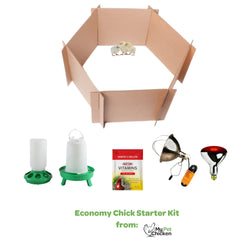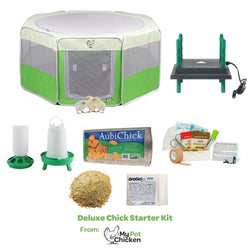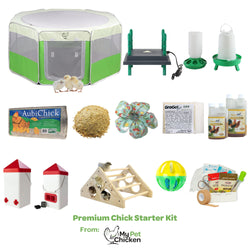All about Omphalitis disease
Back to blog
Imagine a belly-button infection--that's basically Omphalitis. Developing or newly-hatched baby chicks are susceptible to infection of their navels if incubator or brooder conditions are not ideal, or the infection is spread by a well-meaning human. Read on to find out more about this disease and how to prevent it:
Omphalitis Also called
Navel infection, mushy chick, yolk sac infection
Prevalence
Common
Signs
General signs -
Lack of appetite, lethargy, huddling near heat source and fluffed up down. Chicks may also die in shell late during incubation. Loose stools may also be a symptom.
Cardinal or diagnostic signs -
Unhealed, swollen or leaky navel, or distended abdomen
Cause/s
Systemic E. coli, staph, or strep infection from poor incubator sanitation, excessive incubator humidity, dirty eggs set, or dirty litter infecting navel in days-old chicks, occasionally caused by chicks pecking at one another's navels, or by well-meaning caretakers who think they're clearing off a pasted vent. More common in birds hatched in home incubators, where temperature and humidity are not automatically maintained and may be inconsistent.
Communicability
Yes. A chick (or a person) may cause an infection by contaminating a chicks' incompletely healed navel with fecal material. Chicks may consume infected droppings in feed or water. Chickens or people may also inadvertently contaminate egg shells. Washing eggs improperly sometimes pushes any bacteria inside the egg, or provides a moist surface where bacteria can grow.
Communicability to humans
Use common sense and practice good biosecurity--i.e. hand washing--after handling sick chicks, since this illness is caused by bacteria found in fecal matter. If you get it on your hands and then bring your hands to your mouth, you are at risk.
Incubation period
Varies depending on the bacteria causing the infection, however generally not long: a day or two, or present at hatch.
Latent
Yes, survivors may be chronic carriers; however, these bacteria are common
Endemic
Yes. The bacteria causing this infection are found naturally almost everywhere. It can happen in any flock, but is more common in chicks hatched in inexpensive home incubators or chicks hatched by mother hens in excessively dirty nests.
Home treatment and/or prevention
Prevention: Monitor temperature and humidity carefully when hatching. Be sure brooder and nests are clean and dry. Do not incubate dirty eggs. Thoroughly sanitize both incubator and brooder between uses. If a navel hasn't closed on one of your chicks, a strong tincture of iodine can be used on the navel to help prevent the area from getting infected. This likely needs to be done just once or twice before the navel closes. If other chicks are picking at the open navel of one, it's best to separate that chick until they can be safely put back together.
Treatment: Antibiotics may be used, but which and how effective they are will depend on the bacteria causing the infection.
Veterinary care
Consult a vet to get a firm diagnosis and appropriate antibiotics
Recovery
Unfortunately, it can be difficult to save chicks in this condition, especially if they are not eating and drinking. If your vet prescribes antibiotics, you can help by hand feeding to make sure your chick gets enough to eat and drink while she's recovering.
Other conditions, illnesses and/or diseases with similar signs:
Coccidiosis also causes lethargy, loose stools, and huddling near heat sources, but is not accompanied by an open or infected navel. Pasting may be confused with Omphalitis; if you are clearing a vent of pasting, be sure you're looking at the vent, which is under the tail. The navel is further down; you do not want to remove the scab on a healing navel, as it is potentially fatal.
Omphalitis Also called
Navel infection, mushy chick, yolk sac infection
Prevalence
Common
Signs
General signs -
Lack of appetite, lethargy, huddling near heat source and fluffed up down. Chicks may also die in shell late during incubation. Loose stools may also be a symptom.
Cardinal or diagnostic signs -
Unhealed, swollen or leaky navel, or distended abdomen
Cause/s
Systemic E. coli, staph, or strep infection from poor incubator sanitation, excessive incubator humidity, dirty eggs set, or dirty litter infecting navel in days-old chicks, occasionally caused by chicks pecking at one another's navels, or by well-meaning caretakers who think they're clearing off a pasted vent. More common in birds hatched in home incubators, where temperature and humidity are not automatically maintained and may be inconsistent.
Communicability
Yes. A chick (or a person) may cause an infection by contaminating a chicks' incompletely healed navel with fecal material. Chicks may consume infected droppings in feed or water. Chickens or people may also inadvertently contaminate egg shells. Washing eggs improperly sometimes pushes any bacteria inside the egg, or provides a moist surface where bacteria can grow.
Communicability to humans
Use common sense and practice good biosecurity--i.e. hand washing--after handling sick chicks, since this illness is caused by bacteria found in fecal matter. If you get it on your hands and then bring your hands to your mouth, you are at risk.
Incubation period
Varies depending on the bacteria causing the infection, however generally not long: a day or two, or present at hatch.
Latent
Yes, survivors may be chronic carriers; however, these bacteria are common
Endemic
Yes. The bacteria causing this infection are found naturally almost everywhere. It can happen in any flock, but is more common in chicks hatched in inexpensive home incubators or chicks hatched by mother hens in excessively dirty nests.
Home treatment and/or prevention
Prevention: Monitor temperature and humidity carefully when hatching. Be sure brooder and nests are clean and dry. Do not incubate dirty eggs. Thoroughly sanitize both incubator and brooder between uses. If a navel hasn't closed on one of your chicks, a strong tincture of iodine can be used on the navel to help prevent the area from getting infected. This likely needs to be done just once or twice before the navel closes. If other chicks are picking at the open navel of one, it's best to separate that chick until they can be safely put back together.
Treatment: Antibiotics may be used, but which and how effective they are will depend on the bacteria causing the infection.
Veterinary care
Consult a vet to get a firm diagnosis and appropriate antibiotics
Recovery
Unfortunately, it can be difficult to save chicks in this condition, especially if they are not eating and drinking. If your vet prescribes antibiotics, you can help by hand feeding to make sure your chick gets enough to eat and drink while she's recovering.
Other conditions, illnesses and/or diseases with similar signs:
Coccidiosis also causes lethargy, loose stools, and huddling near heat sources, but is not accompanied by an open or infected navel. Pasting may be confused with Omphalitis; if you are clearing a vent of pasting, be sure you're looking at the vent, which is under the tail. The navel is further down; you do not want to remove the scab on a healing navel, as it is potentially fatal.



